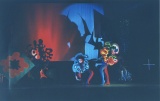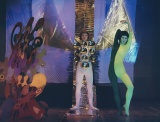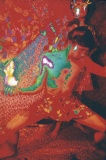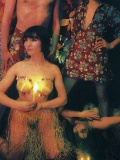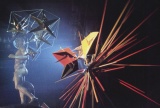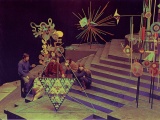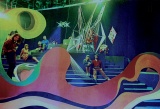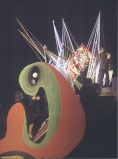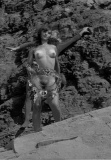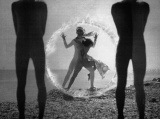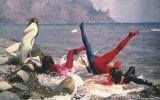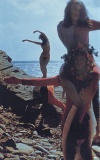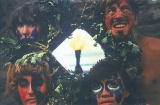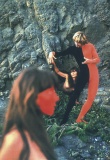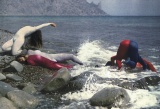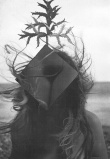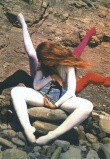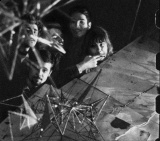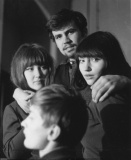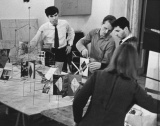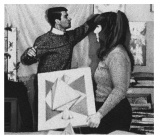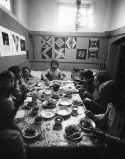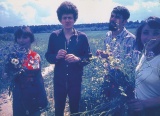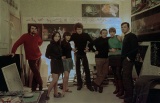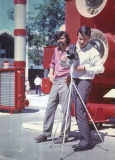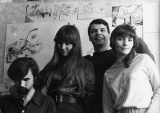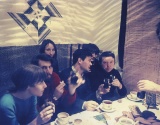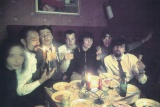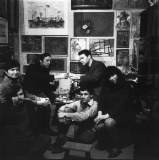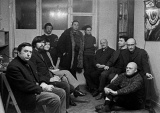Dvizhenie
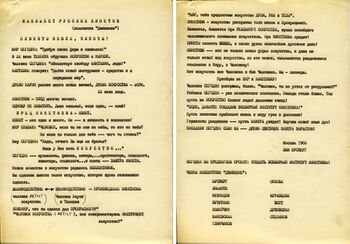
Dvizhenie [Движение, Movement] was an art collective active in Moscow between 1962-1978.
At start of the 1960s, a number of young experimental artists began to convene at a small room in a communal apartment on the outskirts of Moscow, which belonged to Lev Nusberg and was filled with a sizable collection of illegal literature on psychoanalysis, continental philosophy, futurist poetry, albums featuring images of western art and jazz records. Fresh out of the art academy, Nusberg abandoned his early interest in Picasso to pursue his own research into the dynamism of geometric forms. His early works were made of fiber boards painted different colors. He was interested in the concept of symmetry, which he considered a cosmic phenomenon allowing for various elements to coexist in a single composition. It was early in his career that he realized that his geometric constructions, made of crushed eggs cartons and such, shouldn’t just take up the issue of movement in theory, but in practice. The elements of his works began to move around, as did the artist himself as a participant in his own kinetic performances. Eventually, collectively produced industrial optical-reflective sculptures and installations weren’t just moving around their own axis, but they were integrated in his performances and choreographed spectacles. In the meantime, the charismatic Nusberg managed to convince his buddies at the academy to join his collective. One of its new members was Francisco Infante, who was a few years younger than Nusberg. Infante’s approach to the dynamics of geometric forms diverged from the way Nusberg saw them. Infante was fascinated by the idea of infinity, which he considered beyond its cryptic guise as a supernatural phenomenon and, rather, as a phenomenon of movement in space. Hence, in his works, he had a tendency to replicate the same geometric forms multiple times on a varying scale, particularly in his kinetic installations.
These artists used aluminum, plexiglass, mirrors, lightbulbs and other industrial materials, which gave rise to the interpretation of kinetic art as a form of futuristic design. The artists themselves wanted their work to be set firmly in the quotidian, which is why the group took on public projects, such as the decoration of the boulevards and squares of Leningrad of the 50th anniversary of the October Revolution. Many saw it was another instance of the regime inflicting its ambitions upon its artists and it led to several schisms within the group. In addition, some artists, like Infante, were irritated by Nusberg’s dominating personality. In 1966, Nusberg published his Manifesto of the Russian Kinetists, which set the foundation for a scientific-technological revolution that would change the world. Most of the collective’s members didn’t sign the manifesto, distancing themselves further from Nussberg and the group. Dvizhenie ultimately fell apart in 1976, when Nusberg emigrated to Germany, then to the United States. (Source)
History and work[edit]
Besides Lev Nusberg, the first members were Mikhail Dorokhov, Francisco Infante-Arana, Viacheslav Koleichuk, Anatolij Krivchikov, Viacheslav Scherbakov, Viktor Stepanov, and Rimma Zanevskaya. Later, Vladimir Galkin, Juri Lopakov, and others joined the group. From around 1966, Vladimir Akulinin, Galina Bitt, Tatiana Bystrova, Alexander Grigorjev, and Natalia Prokuratova were also members. The group was active on both an artistic and a theoretical level (producing manifestos, scripts and articles as well as artworks), and followed three principles: movement, synthesis, symmetry. The group's manifesto Манифест русских кинетов was written by Nusberg in 1966.
In the mid- to late-1960s, the group turned from the suprematist and constructivist systems to more synthetic environments, or “artificial spaces,” which became Dvizhenie’s main focus for the duration of its history. These took the form of functional design (eg. urban designs celebrating the 50th anniversary of the October Revolution in 1966 in Leningrad) and interior design, and outdoor performance (e.g. the Galaxy Kinetic Complex in 1967).
Infante and Koleichuk left the group in the late 1960s. In 1976, Nusberg with part of the group emigrated to France and Germany, and after a few shows it finally broke up in connection to Nusberg's move to the United States in 1980.
- Ekaterina Dyogot on Dvizhenie
"Nusberg tested out constructivist principles, while Infante engaged and explored the influence of Naum Gabo and Kazimir Malevich (hence his utopian, "supreme" projects, such as a skyscape remade along geometric lines). The collective proclaimed kinetic art meant for mass, ecstatic viewing, and created in an urban setting various synthetic wonders, with flashing lights, transparent plastics, screens, mirrors, smoke, and noise pouring out of loudspeakers. For the most part, this ideological design remained utopian, unhindered by the authorities. "The Movement"'s "live machines" continued El Lissitzky's later illusionist project, first by aspiring to hyper-individualism, but also in their critique of "dry" and "one-sided" geometry. Quite predictably, these artists rejected Western kineticism as too individualistic and its construction as moribund. The collective performances directed by Nusberg essentially appealed to the senses and sexuality -- reliable antidotes to geometry. The group dissolved after Nusberg emigrated to the United States; beginning in the 1970s, Infante worked independently, creating conceptual photographs of artificial objects in nature." (source)
- Margareta Tillberg on Dvizhenie
"Dvizhenie was the first art group in the Soviet Union that worked with cybernetics. In addition to practicing artists, the group cooperated with actors, musicians, chemists, engineers in radio-electronic and light-technology, psychologists, architects, physicists, poets and performing dancers. The text accompanying their exhibition at the Palace of Culture of the Kurchatov Institute for Nuclear Research stressed the necessity of contiguity between art and science. In future cooperation between art and technology, “art is not to be limited to ornamentation, but to be inculcated in the production processes”. The notion of the participation in the “intensive rhythm of life” as one important task – is reminiscent of a slogan from the 1920s.
The cybernetic art of Dvizhenie has the form of kinetic light-colour-sound environments with “life-transforming” content. In 1967 their Cyberevents was shown in the engineering block of the Peter and Paul fortress in Leningrad, followed by Little Eagle, a cybernetics pioneer game-amusement camp in Odessa, and Cybertheater. The Artificial Bio-Kinetic Environment from 1969, was a utopian virtual reality project presenting a future city of 35-40 million people. Paradoxically enough, Dvizhenie’s members were able to move in the circles both of the extremely official (propaganda produced for international trade shows, military and space research, design for control rooms at airports and big industries) and the in-official (free jazz, long hair, drugs, existentialism and Hemingway) - that the people interested in cybernetics, new technology, design, art, bionic-architecture and future urbanism and city planning frequented.
Dvizhenie was the first group in the Soviet Union that succeeded to produce big exhibitions “without content” from the point of view of Socialist Realism ideology. " (source)
Works[edit]
- Mosfilm, 1971
- Kinetic game at Sea (Antonov, Bystrov, Grigoriev, Nedeljko, Bitt, Itsko), filmed by Nusberg, Crimea, 1972
- other works
Cross (1963), Programmed Picture (1963), Soul of Crystal (1964), Space-Movement-Infinity (1963-64), The Flower (1965), The Square of Nine Muses (1965), Galaxy (1967), Cyberevents (1967), Artificial Bio-Kinetic Media (1969).
Photographs[edit]
Exhibitions[edit]
- An exhibition by Vechtomov, Kropivnitsky, Nusberg (A. Ginzburg's apartment, next to the Tretyakov Gallery, 1961).
- Exhibition of kinetic works in the framework of the Exhibition of Geometric Works [Выставка геометрических работ] (Central House of the Artists [Центральный Дом работников искусств], Moscow, 21 Mar-3 Apr 1963)
- Nusberg with his kinetic followers turned the whole interier of Disk club to artistic and musical labyrinth (Disk club, 1964).
- Towards a Synthesis of the Arts [На пути к синтезу искусств], with new members Galkin, Akulinin, Lopakov (Youth club on Marynska street [Клуб на Марьинской улице], Moscow, 1-16 Dec 1964).
- Exhibition-presentation of Kinetic Art [Выставка-представление кинетического искусства], included the work Space of Nine Muses [Площадь девяти муз] (House of the Architects [Дом архитектора], Leningrad, 20 May-6 Jun 1965).
- Nova tendencija 3 - New Tendency 3 (Zagreb, 1965).
- Exhibition-presentation of Kinetic Art [Выставка-представление кинетического искусства], included performances Metamorphoses [Метаморфозы] by Nusberg and Infinity Transformations [Бесконечность превращений] by Infante, and Manifesto of the Russian Kinetists is presented (Palace of Culture of the Kurchatov Institute of Atomic Energy [Клуб Института атомной энергии им. И.В. Курчатова], Moscow, 14-30 May & 3-5 Jun 1966).
- Kunst-Licht-Kunst (Stedelijk Van Abbemuseum, Eindhoven, 1966).
- 50th anniversary of the October Revolution (Leningrad, 1967).
- Scientific and Technical Creativity of Youth [Научно-техническое творчество молодёжи] (1967).
- Documenta 5 (Kassel, 1968).
- 50th anniversary of the Soviet circus (Moscow Manege, 1969).
- Plans and Projects in the Arts (Kunsthalle Bern and Munich, 1969).
- Kinetics (Hayward Gallery, London, 1970).
- Chemistry 70 [Химия-70] industrial exhibition (1970).
- Machine materials 71 [Стройматeриалы-71] industrial exhibition (1971).
- Elektro 72 [Элeктро-72] industrial exhibition (1972).
Publications[edit]
- "Program skupiny Dviženije" [1964], in Dušan Konečný, Hledání tvaru: moskevské a leningradské ateliéry, Prague: Svět sovětů, 1968, pp 21-22. (Czech)
- Lev Nusberg, Manifest russkikh kinetov [Манифест русских кинетов], Moscow, 1966. [2] (Russian)
- "Manifest skupiny Dviženije", Výtvarné umění 17, 1967, p 465. [3] (Czech)
- Lev Nusberg, "Cybertheater", Leonardo 2:1, Jan 1969, pp. 61-62. [4] (English)
- "Das 'Kiber' Theater", Das Kunstwerk / Schriftl. Leopold Zahn. 23, 1969, pp 44-45. (German)
- "Kybernetické divadlo", Acta scaenographica 10:2, 1969/70. (Czech)
- Francisco Infante (ed.), Teksty Frantsisko Infante, Vladimira Akulinina, L'va Nusberga o gruppe «Dvizheniye», napisannyye v otvet na stat'yu Vyacheslava Koleychuka «Gruppa „Dvizheniye“» [Тексты Франциско Инфанте, Владимира Акулинина, Льва Нусберга о группе «Движение», написанные в ответ на статью Вячеслава Колейчука «Группа „Движение“»], c.1996, [68] sheets. Included are the texts: Francisco Infante, "Notes in the margins - Forced Assassination", 1993; Vladimir Akulinin, "Testimony", 1996; Lev Nusberg, "Open Letter", 1991. (Russian)
Catalogues[edit]
- Moskevské kinetické umění, ed. Dušan Konečný, Prague: Galerie na Karlově náměstí, 1965, 6 pp. With text by Dušan Konečný. [5] (Czech)
- Progressive Russische Kunst. Der Abbruch bis 1930: Lev Nusberg und die Moskauer Gruppe "Bewegung", Cologne: Galerie Gmurzynska, 1973, 161 pp. Catalogue, with texts by Szymon Bojko and Michel Ragon. Exh. held 29 Mar-31 May 1973. [6] (German)
- Kollektiv "Dviženie": Gruppe Bewegung Moskau, 1962-1972: Galina Bitt, Tatjana Bystrova, Wladimir Grabenko, Sascha Grigoriev, Francisco Infante, Klawa Nedelko, Lev Nusberg, Natalia Prokuratova, ed. Lev Nusberg, Krefeld: Museum Haus Lange Krefeld, 1973, 28 pp. Exh. held 13 Nov 1973-10 Feb 1974. (German)
- Lew Nussberg, Michel Ragon, Petr Spiegelmann, Lew Nussberg und die Gruppe Bewegung Moskau 1962-1977, Bochum: Museum Bochum, 1978, 206 pp. Exh. held 25 Feb-2 Apr 1978. [7] (German)
- Lew Nussberg: utopische Phantasien: Gruppe Bewegung, Projekte und Installationen, eds. Helga Retzer and Jes Petersen, Berlin: Berliner Künstlerprogramm des DAAD, 1980, [1] leaf. Exh. held 20 Sep-25 Oct 1980. (German)
- Kinetizm: gruppa «Dvizheniye», 1962-1976 [Кинетизм: группа «Движение», 1962-1976], ed. & intro. Aleksandr Grigoryev (Александр Григорьев), afterw. С. A. Zhigalkin, Moscow: Znak, 2016, 280 pp. [8] (Russian)
- Dvizhenie 1962–1976. Kineticheskoye iskusstvo v Rossii XX veka [Движение 1962–1976. Кинетическое искусство в России XX века], ed. Evgeny Korneev (Евгений Корнеев), 2018, 311 pp. [9] (Russian)
Literature[edit]
- Dušan Konečný, "Mladé kinetické umění v SSSR a tradice sovětské avantgardy", Acta scaenographica 7, 1964/65, pp 125-128. (Czech)
- Dušan Konečný, "Mladí moskevští kinetisté", Výtvarné umění 15:9, 1965, pp 420-429. [10] (Czech)
- Dušan Konečný, "Umění v pohybu", My 3:2, 1966, p 36. (Czech)
- Е Касаткина, Е Орлова, "«Движение» в действии", CMeHa 975, Jan 1968. (Russian)
- "Russian 'Movement' Group" (From "CMeHa", No. 1, January, 1968), Leonardo 1:3 (Jul 1968), p 319. Trans. of excerpt. (English)
- Dušan Konečný, "Moskevští kinetisté", in Konečný, Hledání tvaru: moskevské a leningradské ateliéry, Prague: Svět sovětů, 1968, pp 17-42. [11] (Czech)
- Vasilii Rakitin (Василий Ракитин), "‘Dvizhenie’: Mimo konstruktivizma k novoi dekorativnosti", in Drugoe Iskusstvo: Moskva, 1956–76. K khronike khudozhestvennoii zhizni, T. 1 [«Другое искусство». Москва 1956-76. К хронике художественной жизни. Т. 1], eds. Leonid Talochkin and Irina Alpatova, Moscow: Galereia Moskovskaia Kollektsiia (Галерея «Московская коллекция»), 1991, pp 5–14. [12] (Russian)
- Vyacheslav F. Koleichuk (В.Ф. Колейчук), Kinetizm [Кинетизм], Moscow: Galart (Галарт), 1994, 154 pp. [13] (Russian)
- Vyacheslav F. Koleychuk, "The Evolution of My Kinetic Work", trans. Vladimir Chudnovsky, Leonardo 27(5): "Prometheus: Art, Science and Technology in the Former Soviet Union", 1994, pp 395-398. (English)
- Vyacheslav F. Koleychuk, "The Dvizheniye Group: Toward a Synthetic Kinetic Art", 'Leonardo 27(5): "Prometheus: Art, Science and Technology in the Former Soviet Union", 1994, pp 433-436. (English)
- John E. Bowlt, "Art: Development after Stalin", in Modern Russian Culture, ed. Nicholas Rzhevsky, Cambridge University Press, 1998, pp 232-233. (English)
- Lev Nusberg, Negativnye syuzhety: k voprosu ob istorii moskovskoy gruppy "Dvizhenie" [Негативные сюжеты: к вопросу об истории московской группы "Движение"], ed. Francisco Infante, Moscow: samizdat, 2002, 112 pp; 2nd ed., 2006, 192 pp. [14] [15] [16] (Russian)
- Margareta Tillberg, "You are now leaving the American Sector: The Russian Group Dvizhenie, 1962-1978", in Place Studies in Art, Media, Science and Technology, eds. Andreas Broeckmann and Gunalan Nadarajan, Weimar: Verlag und Datenbank für Geisteswissenschaften, 2008, pp 147-165. (English)
- Jane Sharp, "The Personal Visions and Public Spaces of the Movement Group (Dvizhenie)", in Cold War Modern: Design 1945-1970, eds. David Crowley and Jane Pavitt, London: V&A Publishing, 2008. (English)
- myshrooms, "Sovetskoye kineticheskoye iskusstvo: istoriya gruppy «Dvizheniye»" [Советское кинетическое искусство: история группы «Движение»], Sep 2010. [17] [18] (Russian)
- David Crowley, "The Art of Cybernetic Communism", 2011; repr. in Utopian Reality: Reconstructing Culture in Revolutionary Russia and Beyond, eds. Christina Lodder, Maria Kokkori and Maria Mileeva, Brill, 2013, pp 219-238. [19] [20] (English)
- Dmitry Mikheikin (Дмитрий Михейкин), "Художественные группы СССР 1960–70-х: о Льве Нусберге и группе «Движение»", Tatlin News 5, 2012, pp 126–128; cont., Tatlin News 6, 2012, pp 114–116. [21] (Russian)
- Matteo Bertelé, "Lev Nusberg to Harald Szeemann, 1970–76: Notes on Convergent Ambitions and Shared Practices", Getty Research Journal 12, 2020, pp 241-255. [22] (English)
- Laboratoriya budushchego: Kineticheskoye iskusstvo v Rossii [Лаборатория будущего: Кинетическое искусство в России], St Petersburg: Manezh (Манеж), 2020, 580 pp. Catalogue. Exhibition, Exhibition. [23] (Russian)
- Igor A. Bondarenko, Yuri P. Bocharov, Dmitry I. Mikheikin, "The Contribution of the Soviet “Kinetic” Art of the 1960s‑1970s to the Development of the Theory and Practice of Architectural Lighting Technology", Light & Engineering 29:4, 2021. [24] (English)
- Evgeniya Yarkova, "Moscow Experimental Art of the 1960s: Legacy and New Forms in the Works of The Movement Group", Leipzig: Universität Leipzig, 2021, 332 pp. PhD thesis. (English)
See also[edit]
Links[edit]
- Exhibition, Olomouc Museum of Art, 2025.
- 50th anniversary of the group, Moscow, October 2012. [25]
- Photo archive of the group by Alexander Grigorjev.


